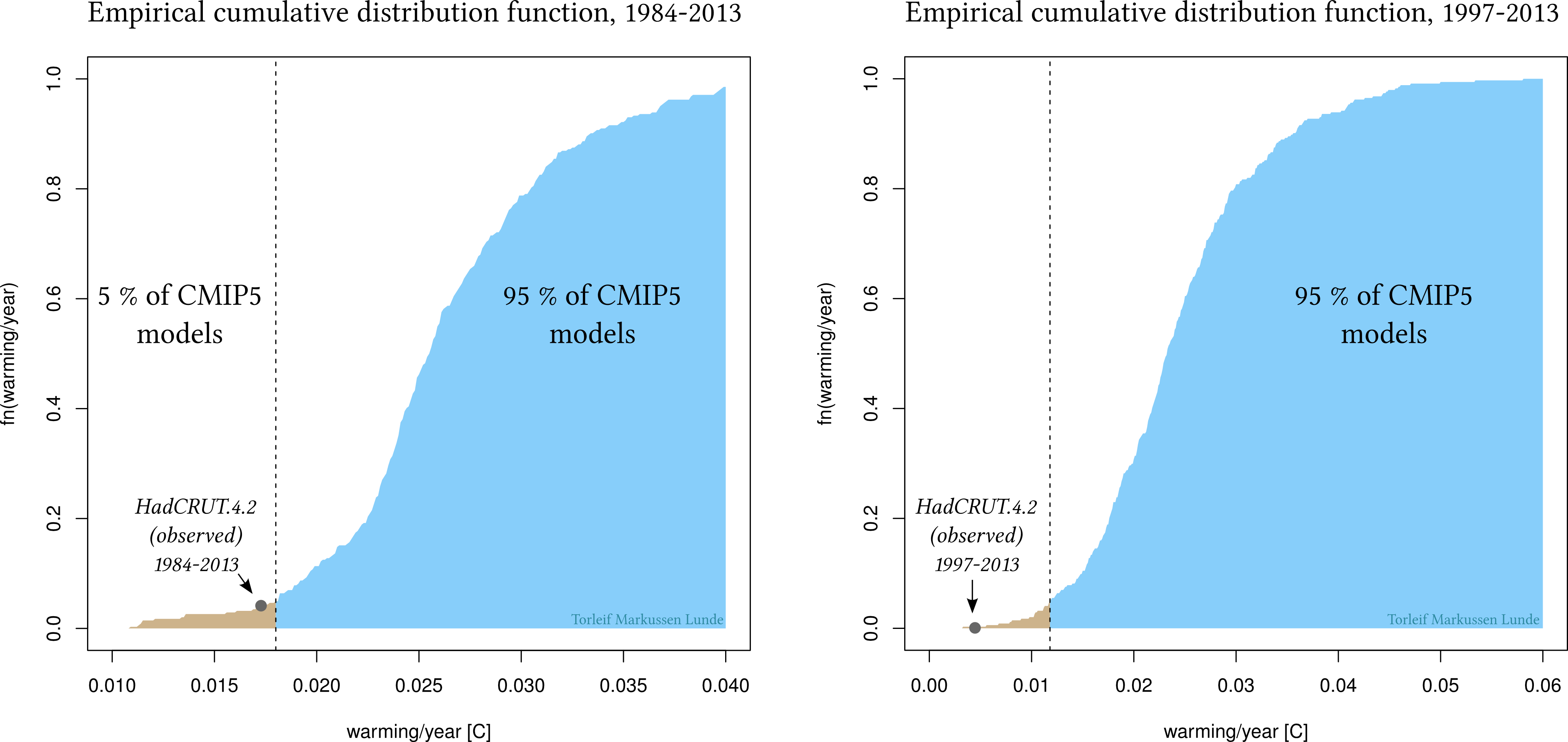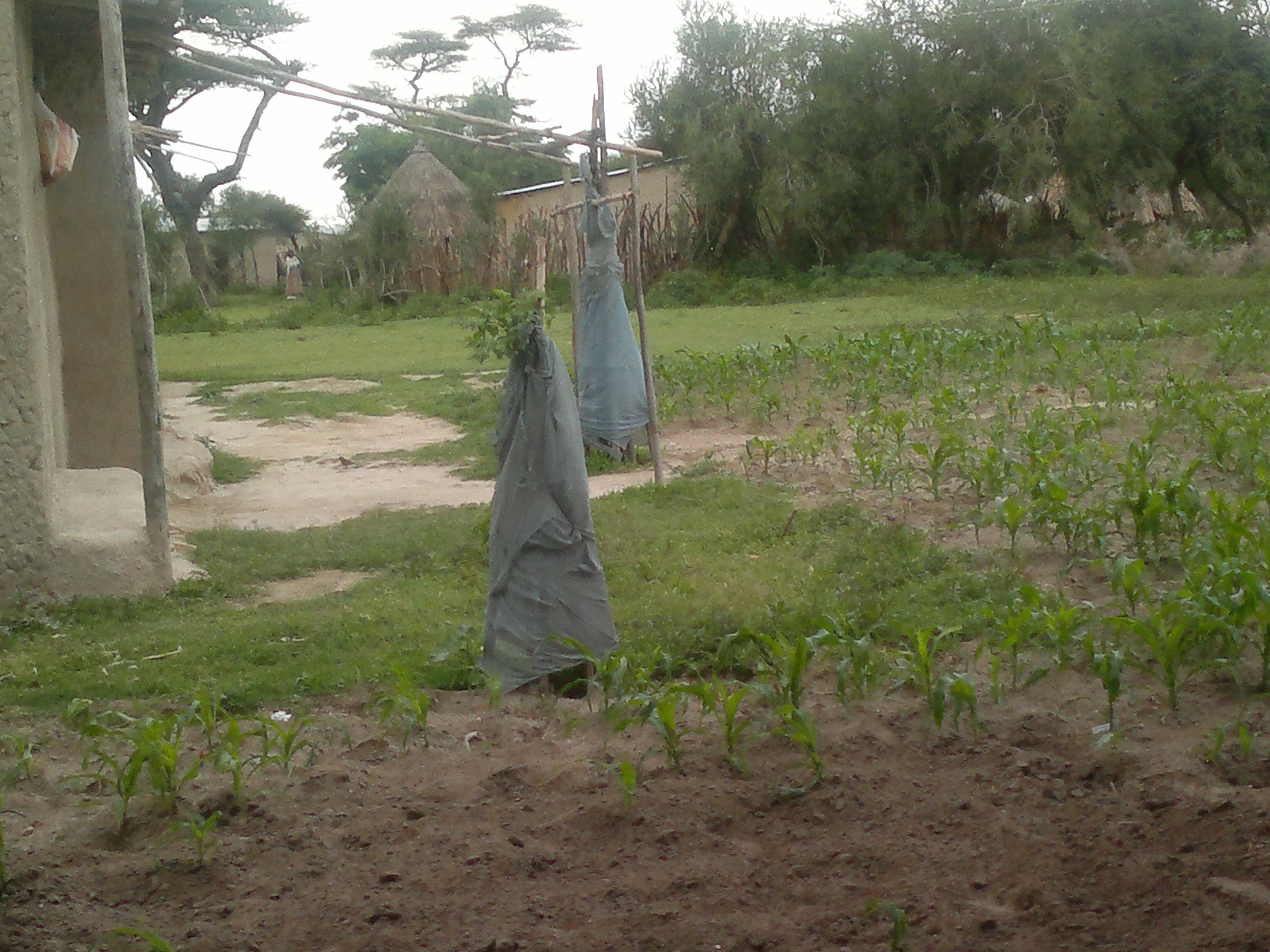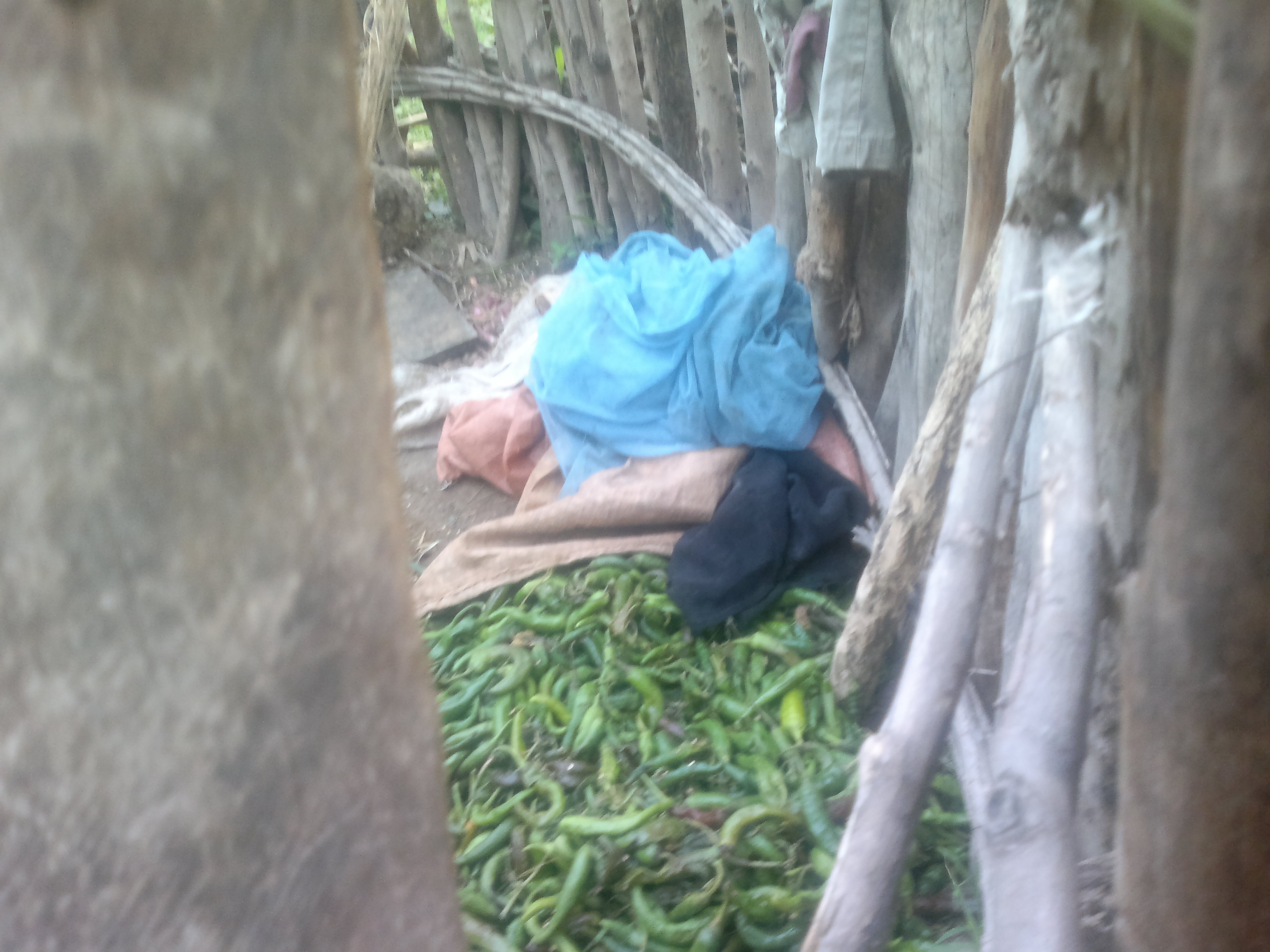

Success story! #Malaria burden decreases in #Mutasa, #Zimbabwe after interventions – http://t.co/oio4WhYtgk #OADW
— BMC (@BioMedCentral) July 1, 2013
BioMed Central wrote this tweet twice twice the last days. They state: “Success story! Malaria burden decreases … after interventions”. Nothing wrong about the last part of the statement. In the article they see a decline in malaria cases after interventions were scaled up, but is it enough to call it a success story? I would love to see evidence malaria declining with or without interventions, and good documentation interventions are working; and I love to see the authors presenting historical data on malaria incidence, but in this case I think BioMed Central forgot it is not a newspaper, but a publisher of scientific articles.
Lets look at the figure behind the “success story”:
What we see is a steady increase from 2003-2008; with IRS, and CQ+SP. After RDTs, ACT and ITNs were introduced we see a steady decline, noting that data from 2011 are not complete. Based on these data I find it hard to claim this is a success story. If we are to believe the data, the number of malaria cases is still higher than 2003-2005, and there are no evidences the recent decline was due to interventions. In my eyes, it could be due to interventions, but as likely is natural variability. The article does not test any hypothesis, and does not prove interventions caused a reduction in malaria cases, but despite this, BioMed Central calls it a “success story”. It seems like BioMed Central might have problems knowing if it is a newspaper wanting to make headlines, or a scientific publisher making evidence based statements. Malaria Journal’s coverage of the same article
Changes in the burden of malaria following malaria control interventions in Mutasa District, Zimbabwe http://t.co/NgczG1ceGS #malaria
— Malaria Journal (@MalariaJournal) July 1, 2013
makes a lot more sense, describing the article in a way which reflects the content. I hope this is a one time mistake from @BioMedCentral.
Last week we started our work in Adami Tullu, Ethiopia. We started collecting mosquitoes, a work which involves walking around in the villages. Over the last year, bednets have been distributed, and most households should own at least one net (and maybe they do). We were able to see some of the nets; used as they should be used, as curtains, in fences, protecting trees and bushes, and used to store food and grass. We were also told by the people, rats taking parts of the nets to build nests is a big problem. Below are some pictures of alternative bednet use.



In a recent article in GRL, Emerging selection bias in large-scale climate change simulations, Kyle L. Swanson describes how experiments might go wrong as we seek a desired solution. He hypothesise a common wish to reproduce the recent warming in the Arctic, has lead to less diversity among models with convergence towards some common solution.
He writes the current generation ensembles of model simulations are statistically inconsistent with the observed shifts in in both the mean surface air temperature as well as the frequency of extreme monthly mean temperature events due to climate warming, despite a marked reduction in the spread among ensemble members that by itself suggests convergence towards some common solution. This convergence indicates the possibility of a selection bias based upon warming rate.
I particularly liked his example of what happened after Robert A. Millikan’s original measurement of the charge of the electron: “Millikan’s original measurement was slightly erroneous due to the use of an incorrect value of the viscosity of air. In the decades following Millikan’s work and his subsequent Nobel Prize, other investigators empirically measured the electron charge. When they got a number that was too high above Millikan’s, they thought something must be wrong–and they would look for and find a reason why something might be wrong. When they got a number close to Millikan’s value they didn’t look so hard. And so they eliminated the numbers that were too far off, and did other things like that.”
In our paper in Malaria Journal, A dynamic model of some malaria-transmitting anopheline mosquitoes of the Afrotropical region. I. Model description and sensitivity analysis, we touch upon this issue by stating “A model is mental copy that describes one possible representation of a system… We present an alternative formulation of the dynamics of An. gambiae s.s. and An. arabiensis… if malaria modelers move towards the ensemble thinking widely adopted in the climate community, this model could be one representation of historical and future changes for malaria. The aim of such an ensemble would be to deal with uncertainties in the system. Ultimately, the goal would be to produce policy-relevant information including uncertainty.”
The basic principles of climate are quite easy to understand; the sun is heating the Earth, with more radiation hitting the equator compared to the poles. Seasons are caused by the tilt of the Earth’s rotational axis away or toward the sun as it travels through its year-long path around the sun. From there you can add clouds, water, ice, land masses, aerosols, precipitation, and even mountain and building shadows if you are interested in local weather. The dynamics of malaria can be simplified in the same manner; an uninfected mosquito bites an infectious human, lives for about ten days, and from that time it can infect new humans every time it bites a human. From this simple model it has been demonstrated that killing mosquitoes is an efficient way of reducing malaria, but it is not able to tell us how efficient. To get a realistic representation of how emissions of greenhouse gasses influence climate, or how malaria is reduced by distributing bed nets we need more complex models together with observations. As we add more realism to the system, we also parameters with uncertainty, uncertainty which was there from the beginning, but which becomes visible as we describe them. If we intended to use an ensemble of models to estimate the effect of for example bed nets against malaria, we could get a very precise estimate if all models were identical, or measured their success by managing to keep malaria away from South Africa (many malaria models predict malaria is widespread there). There are still many things we do not know about malaria, and I hope modellers of malaria do not do the same mistake it seems like global climate models are moving towards; a common solution due to wrong reasons.
A couple of days ago I saw this tweet:
https://twitter.com/francetim/status/330978126211465216
I agree with Tim France, but with the short tweet he also assumes UK will be a rich country with a good health system in 100 years. Below are some thoughts on how we evaluate the impacts of climate change, following up a previous post.
Every time driving a car, there is a chance you will crash. In thunderstorms you might be hit by lightning, and at any time your home could be hit by a meteor. If you drive faster the consequences of a car crash is probably more severe; if you fill your pockets with iron and stand under a tree in a thunderstorm that might be a bad idea; we can increase or reduce the risk of something bad happening. For meteors, well, there is currently not much we can do. What all of these threats have in common is the low probability they will occur, but if they do the result might be devastating.
How are these risks related to malaria in the UK and climate change? The answer is probability. Malaria was common in the in Northern Europe including UK, Sweden and Finland 250-100 years ago, but is no longer a problem. While temperatures declined or showed no trend from about 1750 to the 1920s they have risen since, and we have seen no resurgence of malaria in Europe (except from small outbreaks).
Let us go back to the car. The risk, or probability, of serious injuries in a car crash is dependent on many factors. Increasing the speed will increase the risk, but how do we compare driving a car at 40 MPH without a seat belt to driving the a car at 50 MPH with a seatbelt? From 1750 to 2013 Europe got seat belts and air bags preventing malaria; better houses (less mosquito contact), improved health systems (shorter time to recovery), the population density increased (less mosquitoes per human), and land use changed (less breeding sites for mosquitoes). These factors allowed us to increase the air temperature without increasing the risk of malaria epidemics. So what about the future?
It is virtually certain temperatures will continue to increase the next 100 years. The temperature increase alone will potentially lead to more malaria. But the real impact? Do we assume UK has the same health system in 2100 as today? Will people live in even better houses? What if there is a war in 2080? The IPCC does not make assumptions or scenarios describing alternative realities (on national scales) on how societies will develop the next 100 years. To understand the possible real, and not only theoretical, impacts of climate change, we must also dare to speculate about how society will evolve over the next 100 years. Only then we can come closer to understanding the risk of increasing the speed from 40 to 50 MPH, and know under which assumptions we are making projections about impacts of climate change.
Yesterday an article by Lyons et al., “Stable and fluctuating temperature effects on the development rate and survival of two malaria vectors, Anopheles arabiensis and Anopheles funestus“, was published in Parasites & Vectors. This study is important to understand how climate change, changes in temperature between seasons, and from year-to-year influence the transmission of malaria. In this context it is interesting to see if the new data on Anopheles arabiensis alters the conclusion at which malaria is most efficiently transmitted. We refitted the egg-to-adult survival probability and mosquito development rate models described by Mordecai et al. with the data from the paper by Lyons et al., and calculated R0 according to temperature. While the old estimates for Anopheles gambiae s.s. suggested malaria is most efficiently transmitted at 25.6 C, the new data suggest malaria is most efficiently transmitted (by Anopheles arabiensis) at 25.7 C. The plot is showing transmission potential at the y-axis, and temperature in C at the x-axis. The red line is the estimate by Mordecai et al., while the black line is the estimate with the new data on Anopheles arabiensis.
A new study in Scientific Reports show that diurnal temperature fluctuations are important for a correct description of the dynamics of malaria in the real world. This is a nice addition to the previous work by Paaijmans, and once again it has been shown malaria models should not be oversimplified. Although we are getting closer to understanding how temperature influence malaria transmission, there are still many unresolved questions. In the srep article the authors also show how indoor temperature differ from outdoor temperature, and how this change malaria transmission. I totally agree this is an important factor, even though I do not agree on the functional form of the indoor-outdoor temperature relationship (see MJ article). Anyway, nice work, nicely written. Discussion is a must-read.
A dynamic model of some malaria-transmitting anopheline mosquitoes of the Afrotropical region. II. Validation of species distribution and seasonal variations
Background
The first part of this study aimed to develop a model for Anopheles gambiae s.l. with separate parametrization schemes for Anopheles gambiae s.s. and Anopheles arabiensis. The characterizations were constructed based on literature from the past decades. This part of the study is focusing on the model’s ability to separate the mean state of the two species of the An. gambiae complex in Africa. The model is also evaluated with respect to capturing the temporal variability of An. arabiensis in Ethiopia. Before conclusions and guidance based on models can be made, models need to be validated.
Methods
The model used in this paper is described in part one (Malaria Journal 2013, 12:28). For the validation of the model, a data base of 5,935 points on the presence of An. gambiae s.s. and An. arabiensis was constructed. An additional 992 points were collected on the presence An. gambiae s.l.. These data were used to assess if the model could recreate the spatial distribution of the two species. The dataset is made available in the public domain. This is followed by a case study from Madagascar where the model’s ability to recreate the relative fraction of each species is investigated. In the last section the model’s ability to reproduce the temporal variability of An. arabiensis in Ethiopia is tested. The model was compared with data from four papers, and one field survey covering two years.
Results
Overall, the model has a realistic representation of seasonal and year to year variability in mosquito densities in Ethiopia. The model is also able to describe the distribution of An. gambiae s.s. and An. arabiensis in sub-Saharan Africa. This implies this model can be used for seasonal and long term predictions of changes in the burden of malaria. Before models can be used to improving human health, or guide which interventions are to be applied where, there is a need to understand the system of interest. Validation is an important part of this process. It is also found that one of the main mechanisms separating An. gambiae s.s. and An. arabiensis is the availability of hosts; humans and cattle. Climate play a secondary, but still important, role.
Weather is important for transmission of malaria. The simplest way to measure the current weather is to walk outside and feel whether it is cold or hot, and see if it is sunny, cloudy, or rainy. Weather and climate models always start with a measurement of the current weather. Rather than relying on the perceived conditions, the weather models need accurate observations of the current weather. Such observations can be derived from satellites measuring the temperature, pressure, winds, and vapour content of the atmosphere. In addition, weather balloons can be used to correct the satellite derived observations. Once the current weather has been measured, these observations can be used as initial conditions in climate and weather models, and weather can be foretasted up to ten days ahead. With additional information about the temperature, density and salinity of the ocean, weather can be projected a season ahead. If you add volcanoes, variability of the sun, and greenhouse gasses, it is possible to estimate historical and future weather and climate.
Independent on which time period is of interest, these forecasts, or projections, have to be cover the entire Earth, and the forecasts involves solving millions of equations which demands computational resources. To keep the cost down, the global models are often run with a coarse resolution, dividing the Earth into squares of 250 km x 250 km. In regions where the land is flat for several thousand kilometres, and there is no ocean nearby, these coarse resolutions may be good enough to simulate the weather. Once a mountain, coastline, different land use, or soil types are present, the coarse global models represents the weather poorly. To aid this problem, one can use regional climate models (RCMs).
Regional climate models work by increasing the resolution of the global models in a smaller area, a domain, of interest. Such domain might cover southern Africa, Ethiopia, or western Africa, and resolve the terrain down to one by on km. The global climate model determines the large scale winds, temperatures, pressure, and humidity entering the smaller domain. The regional climate model can then resolve the local impact on weather from land use, orography, soil types etc., giving weather and climate information at much finer resolutions that what is feasible using a global model.
Background
Most of the current biophysical models designed to address the large-scale distribution of malaria assume that transmission of the disease is independent of the vector involved. Another common assumption in these type of model is that the mortality rate of mosquitoes is constant over their life span and that their dispersion is negligible. Mosquito models are important in the prediction of malaria and hence there is a need for a realistic representation of the vectors involved.
Results
We construct a biophysical model including two competing species, Anopheles gambiae s.s. and Anopheles arabiensis. Sensitivity analysis highlight the importance of relative humidity and mosquito size, the initial conditions and dispersion, and a rarely used parameter, the probability of finding blood. We also show that the assumption of exponential mortality of adult mosquitoes does not match the observed data, and suggest that an age dimension can overcome this problem.
Conclusions
This study highlights some of the assumptions commonly used when constructing mosquito-malaria models and presents a realistic model of An. gambiae s.s. and An. arabiensis and their interaction. This new mosquito model, OMaWa, can improve our understanding of the dynamics of these vectors, which in turn can be used to understand the dynamics of malaria.
A dynamic model of some malaria-transmitting anopheline mosquitoes of the Afrotropical region. I. Model description and sensitivity analysis